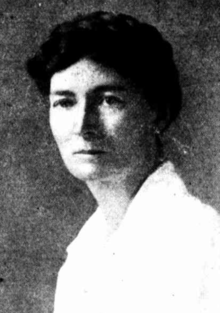Eirene Mort
Eirene Mort (1879–1977) was an Australian artist, art teacher, printmaker, cartoonist, fashion designer and founder of the Society of Arts and Crafts of New South Wales.

Early life
Eirene Mort was born on 17 November 1879 at Woollahra.[1] Her parents were Canon Henry Wallace Mort,[2] an Anglican clergyman, and Kate Macintosh who was the daughter of Robert Isaacs. Mort attended St Catherine's Clergy Daughters' School in Waverley.[1] Mort won the University of Sydney medal for Design in 1897 in her final school exams.[3]
Mort studied painting with Antonio Dattilo-Rubbo and Albert Fullwood.[1] In London, she studied at the Grosvenor Life School, the Royal School of Art Needlework and the Royal College of Art, South Kensington.[1]
Career
Mort illustrated articles she wrote for the Sydney Mail and Art and Architecture,[4][5] and illustrated several books including Florence Sulman's A Popular Guide to the Wild Flowers of New South Wales (1913),[6] The Story of Architecture (1942),[7] and Selwyn Mort's Coins of the Hapsburg Emperors 1619-1919.[8][4] She also wrote and illustrated books about Australian fauna and flora for children including Country cousins.[9] Mort favoured Australian materials and motifs in the decorative arts.[10]
Mort and Nora Weston established a graphic design studio in Sydney in 1906.[4] They offered craft, drawing, design, wood carving, metalwork and book-binding lessons.[4]
Mort was a founder of the Society of Arts and Crafts of New South Wales[4] and one of the organisers of the Australian Exhibition of Womens' Work in 1907 which featured 16,000 exhibits and more than 250,000 people in attendance.[11][12][13]
Mort moved to Mittagong in 1937 and taught at Frensham School.[14] After retiring from the school in 1949, she continued to pursue her artistic career.[14]
The National Gallery of Australia collection includes 349 items of Mort's work.[15]
Personal life
Mort lived with her partner, the wood artist Nora "Chips" Weston, in Vaucluse and later in the southern highlands.[10] Mort died at Bowral on 1 December 1977.[1][16]
References
- Henry, Margaret, "Mort, Eirene (1879–1977)", Australian Dictionary of Biography, National Centre of Biography, Australian National University, retrieved 7 March 2020
- "BLACK AND WHITERS". Daily Herald. South Australia. 10 September 1910. p. 4. Retrieved 9 March 2020 – via Trove.
- Lane, Pamela. "The Amazing Miss Mort | National Library of Australia". www.nla.gov.au. Retrieved 3 April 2020.
- Melbourne, National Foundation for Australian Women and The University of. "Mort, Eirene - Woman - The Australian Women's Register". www.womenaustralia.info. Retrieved 7 March 2020.
- Institute of Architects of New South Wales (1 September 1907), "ART & ARCHITECTURE (1 September 1907)", Art and architecture : the journal of the Institute of Architects of New South Wales, W. Brooks, 4 (5), ISSN 1833-2722
- Sulman, Florence; Mort, Eirene, 1879-1977; Watkins, Dorothy M (1913), A popular guide to the wild flowers of New South Wales, Angus & Robertson, retrieved 7 March 2020CS1 maint: multiple names: authors list (link)
- Mort, Eirene (1942), The story of architecture, Consolidated Press, retrieved 7 March 2020
- Mort, Selwyn R (1959), Coins of the Hapsburg emperors and related issues 1619 to 1919, Hawthorn Press, retrieved 7 March 2020
- Mort, Eirene (1904), Country cousins : presented in picture and rhyme, s.n, retrieved 9 March 2020
- Musa, Helen (21 November 2017). "Arts / Awesome Miss Mort may not ring a bell". Canberra CityNews. Retrieved 9 March 2020.
- "Women's Work Exhibition—The Federal Display in Melbourne". Australian Town and Country Journal. New South Wales, Australia. 30 October 1907. p. 24. Retrieved 9 March 2020 – via Trove.
- Melbourne, National Foundation for Australian Women and The University of. "Australian Exhibition of Women's Work 1907 - Event - The Australian Women's Register". www.womenaustralia.info. Retrieved 9 March 2020.
- Willoughby, Emma (January 2001). "Woman Making An Exhibition Of Herself: The Women's Work Exhibition, 1907". Melbourne Historical Journal. 29 (1): 158–169.
- Morton, Phillip (21 December 2015). "Artist, teacher Eirene Mort moved to Mittagong in 1937". Southern Highlands News.
- Lane, Pamela Joyce (1 June 2018), Eirene Mort: Artist, Artisan and New Woman (PDF), retrieved 7 March 2020
- "NOTICE of intended distribution of estate.—Any person having any claim upon the estate of EIRENE MORT, late of". Government Gazette of the State of New South Wales (Sydney, NSW : 1901 - 2001). 23 March 1978. p. 991. Retrieved 9 March 2020.
Further reading
- Joan Kerr and John McPhee, "First Australian Exhibition of Women’s Work" in Heritage: the National Women's Art Book: 500 works by 500 Australian women artists from colonial times (Roseville East: G+B Arts International, 1995)
- Mort family. (n.d.). Mort Family Papers Mainly of the Mort and Weston Families, Ca.1066-1943, Transcribed with Connecting Narrative by Eirene Mort, 1964.